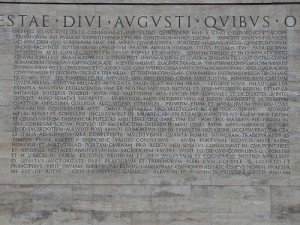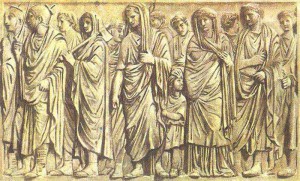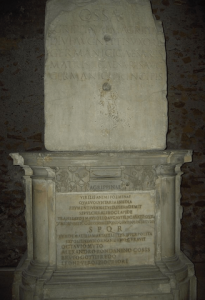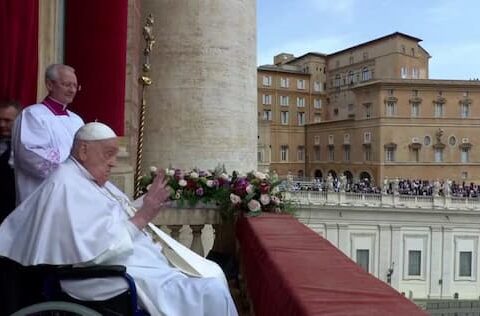The Mausoleum of Augustus should probably rank as one of the most significant historical sites in the world.
We are referring, after all, to what was the final resting place of one of the most important and famous figures of history: and not just of himself, but of his entire family and some of the most notable figures in Roman history.
In modern day Rome, restoration of the Mausoleum of Augustus, built in 28 B.C., has still not been formally undertaken. The cylindrical monument once stood at 120 feet and was crowned by a bronze statue of Augustus himself, the first emperor of Rome and founder of the Roman Empire.
The structure had once contained his own ashes, as well as the ashes of his successors, the Emperor Tiberius (son of Livia) and Augustus’s grandson, the Emperor Claudius.
Sadly, you wouldn’t know that from the condition the place is still in.
Two years ago, as the eternal city prepared to celebrate the 2000th anniversary of Augustus’s death with a series of events and exhibitions, the plans to restore and re-open the mausoleum never materialised as intended, with officials acquiring only half of the four million euros needed. The work was delayed to 2016; but 2016 hasn’t so far seen any visible progress.
And the site continues to be neglected.
The tomb was pillaged, built over and even bombed over the centuries that followed the fall of the empire; ransacked by the Visigoths, later converted to a castle in the 12th century, fired at with cannons, later turned into a garden and used for bullfights, fireworks and concerts.
In modern times, the site was more or less abandoned to ruin, reputedly becoming a haunt for prostitutes and even a toilet for hobos. Plans and announcements of major restoration work to rescue the important site from ruin have been numerous in recent years; but as of yet it appears the site is still in a bad way.
Today, as tourists continue to visit the great Forum or the Colosseum in huge numbers, the Mausoleum of Augustus, situated adjacent to a pizzeria, is barely noticed: and many visitors won’t even know it’s there.
With €2m (£1.6m) in EU funding, archaeologists have been seeking to restore and reopen the site, while Rome’s authorities have reportedly looked to spend €12m on creating a pedestrianised piazza to handle visitors. Rome Commissioner Francesco Paolo Tronca has approved a six-million-euro preliminary project to complete behind-schedule restoration work, as of April this year.
The mausoleum was one of the first projects undertaken by Augustus in Rome following his decisive victory over Antony and Cleopatra at the Battle of Actium in 31 BC.
The mausoleum was circular in plan, consisting of several concentric rings, planted with cypresses on top of the building and possibly capped by a conical roof and a statue of Augustus. Vaults held up the roof and opened up the burial spaces below. Pink granite obelisks flanked the arched entryway.
Suetonius wrote also that Augustus “at the same time opened to the public the groves and walks by which it was surrounded”.
A corridor ran from the entrance and into the heart of the mausoleum, where a chamber with three niches held the golden urns containing the ashes of the Imperial Family.
It is also held that the original text/inscription of Augustus’s ‘Res Gestae’ (‘The Deeds of the Divine Augustus’: a record of his accomplishments and acts that was inscribed after his death and circulated all over the empire) was engraved on bronze pillars placed in front of the deceased emperor’s mausoleum.

Although copies of the Res Gestae (pictured above) have been found in different parts of the world, the original – like the ashes and urns of the interred dynasty – has not survived.
Remains buried within the mausoleum during Augustus’ own lifetime (and before his death) include Marcus Claudius Marcellus (the first to be buried there, in 23 BC), his mother Atia, the legendary general and Augustus’ friend Marcus Agrippa in 12 BC, Nero Claudius Drusus (son of Livia and brother of Tiberius) in 9 BC, Octavia Minor (Augustus’ sister, Mark Antony’s one-time wife and Julius Caesaer’s niece) in 9 or 11 BC, and Augustus’ grandsons Gaius and Lucius, who were meant to be his heirs.
After Augustus died and was interred there himself, the mausoleum later hosted the ashes of Livia (Augustus’ wife and ‘Mother of Rome’), Claudius’s elder brother Germanicus, Agrippina the Elder, Agrippina’s daughter Julia Livilla, Nero (son of Germanicus), Drusus Caesar (son of Germanicus), the insane Caligula, Livia’s son and Augustus’ successor (as emperor) Tiberius, Drusus Julius Caesar (son of Tiberius), Nero Claudius Drusus and Antonia Minor (parents of Claudius), the Emperor Claudius himself, Britannicus (Claudius’s son and intended heir, who was murdered by Nero), the embalmed body of Poppaea Sabina wife of Nero, Julia Domna (later moved to Mausoleum of Hadrian), and finally Nerva, the last emperor to be admitted into the mausoleum.

Unfortunately, although the site remained highly revered throughout the era of Imperial Rome, after Rome’s collapse, marauding barbarians sacked the tomb and it is believed the vandals and robbers simply emptied the ashes of Augustus, Claudius, Livia and the rest of these immense historical figures onto the ground so they could take the urns as booty.
The thought of this has always saddened me, just for the sheer loss to culture and posterity that was so mindlessly inflicted on Rome, Italy and all of us. To think that we might, even now, have had access to the urns holding the actual ashes of the Julio-Claudian family and some of the most enduring, fascinating figures of history would’ve made the Mausoleum of Augustus – in that form – probably the most important historic site in Rome, much more so than the Coliseum, Pantheon or even the Forum.
The resting place of even Germanicus or Tiberius or Livia alone would qualify as a major historic site: let alone all of them in one place.
Perversely, the remains of Augustus, Tiberius and the others may still technically be there, scattered and lost amid all the dirt around the site.
Horribly, specks or particles of them might even have been urinated on by the supposed twentieth and twenty-first century hobos who we’re told have been using the site as a toilet. And that’s a bitter thought.
The cinerary urn (pictured below) that contained the “Bones of Agrippina” now rests in the Palazzo dei Conservatori of the Capitoline Museums, however.

The story is told of how Caligula had ordered the urns of his mother and two brothers to be carried through Rome at noon, when the streets were at their busiest, all the way to the Mausoleum of Augustus.
A scene depicting the return of Agrippina’s ashes to Rome features on a bronze medal displayed at the British Museum.
_________________
Aside from the delay in restoration work on the Mausoleum, officials also had to admit that the extensive stables built by the emperor (and recently discovered during excavations) were to be reburied due to lack of funding. The re-interring of the stables, which had once housed the horses that raced at the Circus Maximus, was another disappointment to the anniversary plans.
At a large excavation site near the Via Giulia, workers were actually reduced to covering up the remains of Augustus’s marbled stables with waterproof cloths for reburial, left for future generations to rediscover at a more opportune time.
Priceless statues, discovered in 2009 by a firm that had been excavating to build an underground car park were reburied, while the buildings had been described as “extremely important”, providing a unique, priceless insight into the imperial stables, with the site reported to have included ancient graffiti on the walls that boasted of victories in races.
Also the Porta d’Octavia in the Jewish Ghetto (named for Octavia, the sister of Augustus and wife of Mark Antony) was still hiding under scaffold. It was being restored, but apparently wasn’t ready for her brother’s anniversary.
In fairness, Italy is experiencing financial struggles at present and archaeology isn’t necessarily the first priority.
However, to mark the two millennia since Augustus’ death in 14 AD, an exhibition was staged in Rome and Paris, while on the Palatine Hill a brand new display of newly restored rooms in Augustus’ house (including elaborate dining area frescoes) was opened to visitors for the first time.
Suetonius wrote of Augustus’ Palatine house as ‘a modest dwelling remarkable neither for size or elegance, having but a short colonnade with columns of local stone and rooms without any marble decorations or handsome pavements. For more than 40 years he used the same bedroom in winter and summer.’
One of the great historic sites associated with Augustus and known to historians, but thought to be lost to us is the ‘Temple of Divus Augustus’, which was a major temple originally built to commemorate the deification of Augustus. It was built between the Palatine and Capitoline Hills, behind the Basilica Julia, and supposedly on the site of the house that Augustus (then called Octavian) had lived in before he entered public life in the mid-1st century BC.
The temple’s construction reportedly took place during the 1st century AD, having been pledged by the Senate after Augustus’s death AD 14. It is unknown whether the site was constructed by his stepson and wife Tiberius and Livia or by Tiberius alone; but it wasn’t until after Tiberius was dead that the temple was completed and dedicated by his insane successor Caligula. The long-awaited dedication ceremony is believed to have taken place in August of 37 AD.
According to historian Cassius Dio, the commemorative events arranged by Caligula included a two-day horse race that was accompanied by the slaughter of 400 bears and “an equal number of wild beasts from Libya”. According to this account, Caligula froze all lawsuits and suspended all mourning so that “no one should have an excuse for failing to attend”.
The last known reference to the temple was in 248 AD; at some point thereafter it was completely destroyed and its stones were presumably quarried for later buildings.
Its remains are not visible and the area in which it lay has never been excavated. Which somewhat serves to remind us that, for every great monument or structure rediscovered, there are many more gone forever. Which also reinforces why it is so important to preserve and maintain those historic treasures that are with us: such as the Mausoleum of Augustus.
It is a fascinating insight into Augustus’s psychology that he intended the site to host the remains of not just himself but his entire family and dynasty: and that he even knew a dynasty would ensue. This may, however, have been prompted in part by the premature deaths of various members of his family while he was still alive.
In addition to the abject condition of the Mausoleum, it remains an even greater shame that the ashes and urns haven’t survived. The Mausoleum can at least to some extent be revived and restored; but those remains sadly never can be.
It also occurs to me, with some sense of perverse irony, that the resting place and even the remains of Augustus’s great rival Mark Antony may ultimately have the final victory: as there remains a possibility Antony’s resting place could still be discovered in Egypt if Cleopatra’s is.
In terms of the Augustus Mausoleum, however, when (or if) the restoration is completed, the Mausoleum will certainly become one of Rome’s major attractions and may even be able to compete with the Coliseum.
Whenever I think on stories like these, and particularly regarding the Mausoleum of Augustus, I immediately hear the words of the elderly Claudius towards the end of the final episode of the truly brilliant I Claudius TV series; having just seen apparitions of his deceased relatives, including Livia, Caligula, Tiberius and Augustus, Claudius ends his final appearance in the Senate with an evocative, poetic reflection on Rome and the dynasty of which he was a part, ending with “Yes. And one day, they will all live again. The dead will come to life. The man who dwells by the pool will open graves… and deliver Rome up again”.
________________________
More: ‘History Struggling to Survive: The BEN HUR Villa & the Palace of Nero‘
________________________




